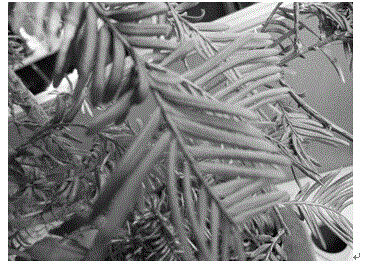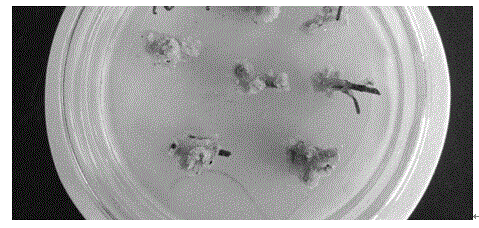Taxus chinensis cell strain with high-yield paclitaxel characteristic and application of taxus chinensis cell strain
A yew cell and paclitaxel technology, applied in plant cells, fermentation and other directions, can solve problems such as endangering yew resources, low paclitaxel content, damage to the environment, etc., to solve the problems of frequent felling and planting, simple extraction, separation and purification, and protect the earth. The effect of the environment
- Summary
- Abstract
- Description
- Claims
- Application Information
AI Technical Summary
Problems solved by technology
Method used
Image
Examples
Embodiment 1
[0048] Induction of a high-yielding cell line of paclitaxel, preservation number CGMCC No. 10002
[0049] The process of obtaining callus preservation number CGMCC No.10002 from the cell lines induced by the explants of Taxus chinensis var. mairei is: cleaning the explants, disinfecting with 75% alcohol, disinfecting with 0.1% mercuric chloride, inoculating and culturing [4] . See attached figure 1
[0050] 1. Explant disinfection
[0051] 1.1 Cleaning
[0052] Put the explants in a basin of clean water, add a small amount of detergent, gently rub the surface of the explants with your hands, then rinse with clean tap water 3 times, rinse with purified water 3 times, and finally rinse with ultrapure water 3 times. After washing, place it on clean filter paper, separate the leaves from the tender stems, place the leaves in a plate with clean filter paper, absorb excess water, and cover the lid. Cut the tender stems into small sections with scissors, and place them in a petri dish wit...
Embodiment 2
[0065] Subculture of callus of paclitaxel-producing cell line.
[0066] After the cells are successfully induced, they will be subcultured every 21 days. During the subculture process, the cells will brown and become dry. The problem of browning was solved by adjusting the subculture medium and adding anti-browning agents. After a series of experiments, VC, PVP, L-glutamine, etc. were added. After subculture adjustment, it was transferred to B5+2,4-D(1mg / l) + 6-BA (0.1mg / L) + L-glutamine (0.2928g / L) + VC (100mg / L), the cell status is stable and the browning is reduced; the cells are stable for passage. See attached image 3 .
Embodiment 3
[0068] Taxonomic identification of strains:
[0069] The identification method selects 18S rDNA ITS sequencing, and then conducts systematic evolution analysis based on the sequence, and conducts species identification from genetic biological information. Extraction of whole plant cell genome DNA: Operate according to the instructions of Shanghai Shenggong Company Ezup Column Type Plant Genomic DNA Extraction Kit SK8261; without liquid nitrogen, grind in the Buffer PCB solution heated directly in the material, and place the whole plant genome after TE dissolution. Store frozen at -20°C; PCR and nucleic acid electrophoresis: Primer pair: rDNA-18S-F sequence: 5'- GCG GTA GGA TCA TTG TCG-3'; ITS4-R sequence: 5'- TCC TCC GCT TAT TGA TAT GC- 3'Synthesized by Shanghai Shenggong Company, and the substrate is the extracted and purified plant cell DNA. Perform PCR according to the instructions of the Shanghai Biotech Taq PCR Master Mix Kit BS9293; after PCR, perform 1% w / v agarose gel el...
PUM
 Login to View More
Login to View More Abstract
Description
Claims
Application Information
 Login to View More
Login to View More - R&D
- Intellectual Property
- Life Sciences
- Materials
- Tech Scout
- Unparalleled Data Quality
- Higher Quality Content
- 60% Fewer Hallucinations
Browse by: Latest US Patents, China's latest patents, Technical Efficacy Thesaurus, Application Domain, Technology Topic, Popular Technical Reports.
© 2025 PatSnap. All rights reserved.Legal|Privacy policy|Modern Slavery Act Transparency Statement|Sitemap|About US| Contact US: help@patsnap.com



